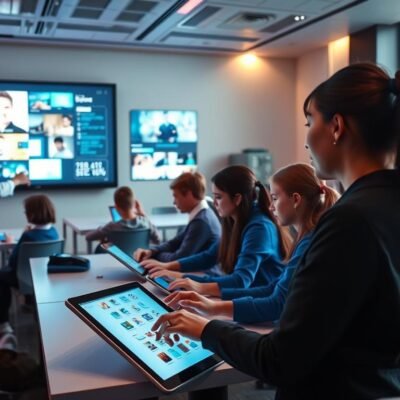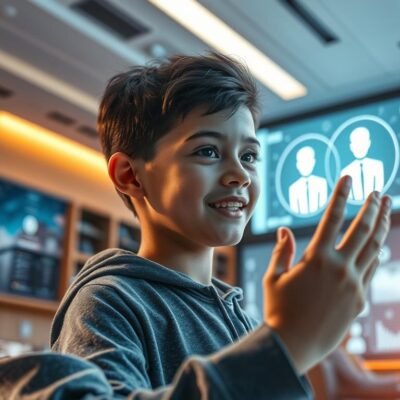Imagine holding a beating heart in your hands during biology class or walking through ancient Rome in history lessons. This isn’t science fiction – it’s today’s educational landscape. Modern tools are reshaping how knowledge gets absorbed, turning ordinary lessons into multi-sensory adventures.

Educators across the U.S. are adopting cutting-edge solutions that blend physical and digital elements. These methods help visual learners see complex models, auditory learners hear historical speeches, and tactile learners interact with 3D structures. The result? 92% of teachers report increased participation when using these tools, according to recent EdTech surveys.
Traditional lectures now coexist with dynamic content displays. A geometry class might project 3D shapes onto desks, while language students practice conversations with virtual characters. This approach doesn’t replace textbooks – it makes them come alive.
Key Takeaways
- Interactive tech creates multi-sensory educational experiences
- Digital overlays boost engagement across learning styles
- Complex subjects become easier through 3D visualization
- Teachers gain new methods for assessing student progress
- Hybrid approaches blend physical and digital resources
The Basics of AR in Education: Understanding the Digital Classroom
Picture students exploring the solar system from their desks or dissecting virtual frogs without scalpels. This is the magic of blending physical spaces with digital enhancements. Today’s classrooms use smart tools to layer interactive elements onto everyday lessons, creating bridges between abstract ideas and tangible understanding.
Defining Augmented Reality in Learning
Augmented reality adds digital layers to your surroundings through screens or glasses. Think of pointing a tablet at a textbook page and watching 3D diagrams pop up. These visual helpers make tricky topics click by letting you rotate molecules or watch historical events unfold on your desk.
Unlike virtual reality’s fully digital worlds, AR keeps one foot in the real environment. Your device’s camera spots objects like maps or lab equipment, then overlays animations, sounds, or data. Teachers love how it turns passive lessons into hands-on discovery sessions.
The Shift from Immersive Classrooms
Remember overhead projectors and chalkboards? Modern setups use smart devices to boost traditional tools. A geography poster becomes interactive when scanned, showing climate changes over time. Students collaborate on floating 3D models instead of flat drawings.
This blend keeps familiar materials relevant while adding depth. You’re not replacing textbooks – you’re giving them digital superpowers. Lessons adapt to different learning speeds, letting fast learners explore bonus content while others get visual reinforcements.
How augmented reality is transforming classroom learning
Step into a living textbook where diagrams leap off pages and historical events replay on desks. Today’s tools let learners grab floating planets or assemble DNA strands mid-air. These aren’t magic tricks – they’re interactive experiences powered by digital overlays that turn abstract ideas into tangible explorations.
Interactive Experiences and Real-Time Content Integration
Imagine rotating a carbon atom with your fingertips or walking through a virtual Colosseum. Systems now adapt instantly based on how quickly learners grasp ideas. If you struggle with geometry angles, the program might project 3D shapes onto your desk for hands-on practice.
One teacher shared:
“My class solved molecular structures 40% faster after using dynamic visual aids. They’re not just watching – they’re doing.”
Real-time adjustments keep lessons fresh. Advanced learners unlock bonus challenges, while others get extra visual guides. Subjects like chemistry become accessible when you can:
- Combine virtual elements safely
- Observe reaction simulations
- Receive instant feedback on experiments
This approach turns passive listening into active problem-solving. You’re not memorizing facts – you’re testing theories and seeing immediate results. Retention rates climb as curiosity drives exploration, proving that engagement thrives when lessons feel like adventures.
Immersive Learning Experiences: AR & VR in Action
Your classroom walls dissolve as you step into the Sahara’s shifting sands or navigate Mars’ rocky terrain. These adventures happen through smart glasses and tablets, creating boundless educational journeys that spark curiosity. Let’s explore three ways these tools reshape discovery.
Virtual Classrooms and Digital Field Trips
Why read about Egypt’s pyramids when you can walk through their hidden chambers? Teachers now guide tours of coral reefs and WWII battlefields using spatial computing. One educator noted:
“My class visited all seven continents in one week. Their questions showed deeper understanding than textbook quizzes ever revealed.”
Gamified Learning and Collaborative Projects
Math becomes an alien invasion game where solving equations saves cities. History transforms into time-travel quests to recover artifacts. Students team up in shared digital spaces, manipulating 3D models of tectonic plates or Renaissance art. These activities build teamwork while making abstract concepts click.
Safe Simulations for Complex Concepts
In science labs, learners mix volatile chemicals virtually or observe cellular mitosis up close. No safety goggles needed. AR creates risk-free zones to:
- Test engineering designs
- Practice emergency response protocols
- Explore microscopic organisms
These environments adapt as you experiment, offering instant feedback. Mistakes become teachable moments rather than disasters. Whether dissecting digital frogs or rebuilding ancient cities brick by brick, immersive learning turns theory into tangible experiences.
Key Benefits and Impact on Student Engagement
Picture a math equation turning into a 3D puzzle you solve by moving pieces through space. This blend of play and study shows why modern tools captivate young minds. Recent research reveals students using interactive tech recall 45% more information than through textbooks alone.

Enhanced Engagement and Improved Retention
When lessons become adventures, participation skyrockets. Imagine rebuilding ancient civilizations block by block or watching chemical bonds form in real time. These experiences stick because they activate multiple senses:
- 72% better recall of science concepts
- 68% faster problem-solving in math
- 53% longer attention spans during lessons
One high school teacher reported: “My class’s test averages jumped 19 points after introducing spatial learning tools.”
Personalized and Adaptive Learning Journeys
Every learner gets a unique path. Struggling students receive visual guides that simplify complex ideas, while advanced peers unlock bonus challenges. Systems automatically adjust content based on:
- Individual progress rates
- Preferred learning styles
- Knowledge gaps needing reinforcement
This flexibility lets you explore topics at your ideal pace. You’re no longer racing to keep up or waiting for others – the material evolves with you.
Practical AR Tools, Devices, and Real-World Applications
Unlock interactive 3D models of the human body using just your smartphone or explore architectural wonders through specialized glasses. Modern educational tools blend everyday devices with powerful spatial computing to create unforgettable lessons.
Cutting-Edge AR Devices and Applications
Your existing tech becomes a learning powerhouse through apps like JigSpace. This platform lets educators build 3D presentations without coding – perfect for demonstrating engine mechanics or planetary orbits. Tablets transform into anatomy labs with 4D Anatomy, where you can peel back muscle layers or rotate skeletal structures.
Layar turns printed materials into interactive portals. Scan a history textbook page to watch battlefield reenactments play out on your desk. For deeper immersion, AR glasses like Microsoft HoloLens project life-sized DNA models you can walk around and examine.
Case Studies and Success Stories in Education
Esade Business School’s virtual campus shows what’s possible. Their Executive Education students attend lectures in a digital auditorium, collaborate in futuristic meeting rooms, and even unwind with virtual sports. One professor noted:
“Participation rates doubled when we moved case studies to the metaverse environment.”
Public schools report similar wins. A Texas district saw 34% higher test scores in biology after implementing 4D Anatomy. Teachers appreciate how these tools adapt to different learning speeds – visual learners get 360° diagrams, while hands-on learners manipulate virtual objects.
Implementation costs vary widely. Many schools start with free apps on existing tablets, while universities invest in premium devices. The key? Matching technology to educational goals rather than chasing the shiniest gadget.
Challenges and Future Considerations for AR in Education
While interactive 3D models grab headlines, schools face real-world hurdles bringing these tools to every desk. Budget constraints and tech gaps create uneven playing fields, but creative solutions are emerging to bridge these divides.

Implementation, Cost, and Teacher Training Challenges
High upfront expenses for devices and software strain tight school budgets. A single classroom set of AR glasses can cost more than a year’s supply of textbooks. Teachers need time to master new systems – time many don’t have during packed schedules.
Key barriers include:
- Device accessibility gaps between income groups
- Ongoing software licensing fees
- Limited IT support for troubleshooting
One principal shared:
“We want to innovate, but must choose between fixing leaky roofs and buying AR headsets.”
Embracing AI and Emerging Immersive Technologies
5G networks promise smoother real-time collaborations in virtual labs. AI-powered tutors could soon adjust lesson difficulty as you work, like a personal coach spotting when you struggle with fractions.
Affordable options are coming:
- Phone-based AR apps eliminating hardware costs
- Cloud platforms reducing local storage needs
- AI lesson builders creating custom activities
These advances aim to make immersive tools as common as whiteboards. The goal? Ensuring every student gets equal access to tomorrow’s learning methods, regardless of zip code.
Conclusion
You’ve seen students interact with DNA strands as easily as building blocks and explore coral reefs without leaving their seats. These tools aren’t just flashy gadgets—they’re reshaping what’s possible in education. By blending digital layers with real-world environments, complex ideas become playgrounds for discovery.
Studies confirm that immersive experiences boost understanding across subjects. Imagine practicing chemistry with zero risk or walking through historical events as they unfold. This approach meets learners where they are, adapting to individual needs while keeping curiosity alive.
The future holds exciting possibilities. As technology becomes more accessible, classrooms everywhere could offer personalized journeys through time, space, and science. Your role? Stay open to new methods that turn abstract concepts into tangible adventures—because when lessons feel real, they stick.


